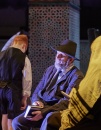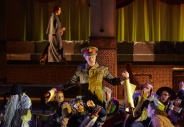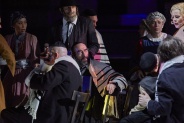Nabucco
Between fanaticism and idolatryThoughts on the production of Verdi's NabuccoIn Nabucco, the young and anti-clerical Verdi deals with the profound, century-old conflict between religion and idolatry. In the opera, this antagonism is expressed unequivocally: Judaism faces the deities of Baal, and Jerusalem – the Holy City, that spiritual epicentre – faces Babylon, the symbol of opulence and corruption. While these divergences have remained clear and indisputable for millennia - and the resulting conflicts have been an ongoing issue for the Middle East - this perception has paradoxically reversed in the last century. For during the years of the British Mandate in Palestine, from the 1920s to the 1940s, Jerusalem was baptised the new Babylon. From this modern contradiction comes a simple question: who in the last century represented Babylon, the Orient or rather the Occident? For the staging of this Nabucco I have decided to follow this alternative perspective, to explore the history of Jerusalem especially in the first half of the 20th century, and to examine critically the political, geopolitical and especially commercial interests that the West persecuted in the city and still does today. The priests of Baal are representatives of various churches and interest groups who undermine the decisions of the new Western government, while the Hebrews - with their growing zeal and activism - are firstly only a means to an end, and increasingly become a real burden for the governing British mandate in Palestine. In parallel to the passionate history of Jerusalem, to the resoluteness of the Jewish people, to the cult of ostentation imported from the West, hinges a family tragedy. Nabucco, the politician, the inhuman man, does not endure the confrontation with his private and personal tragedy. These parallel actions in Nabucco’s plot mesh together; fanaticism and idolatry become the real reason for the destruction of Nabucco himself as well as of his daughters.
Press comments
Pamela Recinellas hoch spannende „Nabucco“-Inszenierung für das Mainfranken Theater, die am Samstag Premiere feierte, kommt freilich ohne tagespolitische Anspielungen aus. Die italienische Regisseurin siedelt das Stück während des britischen Mandats in Palästina an, wobei Jerusalem zum Babel aus dem Libretto wird und die Hebräer damit zu Deportierten im (noch nicht) eigenen Lande.Interessanterweise gelingt es Recinella, vor diesem komplizierten zeitgeschichtlichen Hintergrund die an vielen Stellen nicht minder verwirrende Handlung schlüssig und stringent zu erzählen. Die Schnittstelle dafür ist die Titelfigur: Nabucco, hier größenwahnsinnig gewordener Kolonialoffizier, sprengt sozusagen den Rahmen sachlicher Kausalitäten.
Pamela Recinella's highly exciting staging of Nabucco for the Mainfranken Theatre, which premiered on Saturday, certainly goes without any day-to-day political allusions. The Italian director sets the play during the British Mandate in Palestine, with Jerusalem becoming the Babylon of the libretto, thus depriving the Israelites of their (not yet) own land. Interestingly, Recinella succeeds in many places against the complicated and confusing action of Nabucco in telling coherently and exactingly this complicated contemporary historical background. The interface for this is the title character: Nabucco, here megalomaniac colonial officer, bursts, so to speak, the context of factual causalities.
Mathias Weidemann, Main-Post
Musik und Bühnenspiel stehen in Pamela Recinellas Inszenierung auf einer Ebene. Schon bei der Ouvertüre herrscht buntes Treiben oberhalb des Orchestergrabens (..) Haus- und Extrachor ist in ständiger Bewegung, schlüpft aktiv in Rollen, ist Handlungsteil der Inszenierung (…) sorgen für ergreifende wie erhabene Momente. (..) Optisch setzt Pamela Recinella auf der Bühne auf Opulenz. Die britische Bühnen- und Kostümbildnerin Madeleine Boyd hat dafür ein detailreiches, sehr ästhetisches Bühnenbild geschaffen mit viel Tiefe für verschiedene Handlungsebenen. Mit Verdis »Nabucco« präsentiert das Mainfranken-Theater (…) eine sehr aufwändig inszenierte Oper.
Music and action work in Pamela Recinella's staging on one and the same level. Already during the Overture there is a great deal of activity above the orchestra pit; the chorus are in constant motion, slipping actively into roles, forming an integral part of the production, [and] the action provides poignant as well as sublime moments. Pamela Recinella provides a visual opulence on the stage, [for which] the British stage and costume designer Madeleine Boyd has created a highly detailed, very aesthetic stage design with a lot of depth for different levels of action. With Verdi's Nabucco, the Mainfranken-Theater (...) presents a very elaborately staged opera.
Michaela Schneider, Main-Echo
Recinella hat ihren Transfer gut durchdacht und in greifbare, unmittelbar einleuchtende Bilder gebracht. Sehr genau verwebt sie die komplexe politische Geschichte – Zaccaria und Ismaele im Widerstand gegen das fremde Herrschaftssystem – mit der privaten Katastrophe einer Familie: Nabucco, ein gefühlskalter Vater mit Empathie nur für Macht, hat für Gespräche mit seinen Töchtern offensichtlich keine Zeit. Fenena ist diejenige, die sich aus Liebe mit der revolutionären Partei solidarisiert. Und Abigaille irrt zwischen allen politischen Stühlen und emotionalen Fronten – eine verlorene junge Frau, die zu letzten Mitteln greift, um ihr eigenes Gefühls-Desaster in den Griff zu bekommen, um endlich auf sich aufmerksam zu machen und ihre unerträgliche Lage offensiv zu überwinden. Täterin und Opfer zugleich. Die Regisseurin bleibt an ihren Personen dran, behält sie stets im Auge. So gibt es keinen Leerlauf, so konventionell manche Szene auch auf den ersten Blick von Verdi und seinem Librettisten Temistocle Solera konzipiert sein mag. Recinella schafft es, mit einem Stück, das sich gerne dem Zugriff verweigert, eine schlüssige Geschichte zu erzählen. Und sie kann sich auf die Musik verlassen: So vorläufig Verdis Mittel auch sein mögen, sein leidenschaftlicher Zugriff, seine scharf geschnittenen Cabaletten, seine damals schon fantastisch erfundenen, kraftvollen Melodien tragen das Konzept mit.
Recinella has thought out her conception thoroughly and made it into tangible, immediately plausible scenic images. She closely interweaves the complex political history – Zaccaria and Ismaele in resisting the alien system of rule - with the private catastrophe of a family. Nabucco, an emotional father with empathy for power, has no time for talking with his daughters. Fenena is the one who fraternises out of love with the revolutionary party. And Abigaille – perpetrator and victim at the same time – is wandering between all political positions and emotional fronts: a lost young woman who is pushed to the last resort in order to get her own emotional disaster under control, in order to overcome her intolerable situation. The director stays with her characters and always keeps an eye on them, so there is no let up, as conventional as some scenes may appear to be designed by Verdi and his librettist Temistocle Solera. Recinella manages to tell a coherent story with a piece that usually denies such access. And she can rely on the music: as provisional as Verdi's means may be, his passionate accents, his sharply cut cabalettas, his powerful melodies carry the work.
Werner Häußner Online Merker
Mit ihrem fast viertelstündigen Schlussapplaus belohnten die Premierenbesucher die gewaltige Kraftanstrengung aller Mitwirkenden für eine anregende Inszenierung, die sichtbar machte, wie dünn das Eis im Spannungsverhältnis zwischen Macht und Menschlichkeit, von Liebe und Verrat, Glaubenseifer und Nächstenliebe zu werden vermag.
With their almost fifteen-minute final applause, the premiere audience rewarded the tremendous efforts of all participants for their inspiring production that made visible how thin the line is between power and humanity, love and betrayal, zeal for faith and charity.
Felix Röttger, Fränkische Nachrichten

























